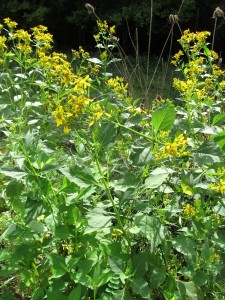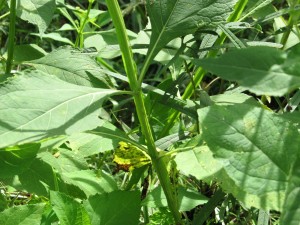In late summer several wildflowers, golden rods (Solidago spp.)and ironweeds (Vernonia spp.) to name two, start blooming along many Midwestern and Eastern U.S. roadsides. Wingstems (Verbesina alternifolia) are another 4-8 feet tall native perennial wildflower that grows nearby (USDA hardiness zones 4-7). Many people ask what they are.
Sturdy stems, mostly unbranched, stand tall and are topped by panicles of bright yellow flowers. Raised ridges (called wings) line the stem; this feature makes it easy to identify. Numerous white hairs cover the stems. At first sighting the lower leaves in late spring are ovate-shaped and arranged opposite along the stem. Summer leaves are alternate and lanceolate, 5 to 9 inches long and 2-3 inches wide, and are tapered at the base. Leaf surface is medium green and sandpapery in feel.
Starting in late summer the dome-shaped panicle flowers open. Blooming period lasts a month or more. Blooms, composed of both ray and small disc flowers, are 1-2 inches across. The ray blossoms are daisy-like and showier. Seeds quickly ripen in the fall and most drop to the ground or carried away by the wind.
Wingstem prefers moist organically-rich fertile soils and full sun, but can handle light shade. Habitats are usually adjacent to woodland areas or bodies of water, such as moist prairies, meadows, pastures, and roadside ditches. Lower leaves often shrivel and drop off when summers are exceptionally hot and dry.
Foliar diseases are rare unless plants are under weather stress. Nectar feeding bees, particularly bumblebees, butterflies, and moths frequent the flowers. Some caterpillars of the Silvery Checkerspot butterfly (Chlosyne nycteis) gnaw on the foliage, and caterpillars of the Gold Moth (Basilodes pepita) feed on the flowers and developing seeds. Deer, rabbits, and other herbivores usually bypass wingstems.
Wingstem, sometimes called “yellow ironweed” and purple-flowered ironweed are often observed growing together. Both plants bloom in very late summer, grow to similar heights, have similar foliage, and prefer moist sunny habitats. Root systems of both species are rhizomatous and tend to form vegetative colonies.



 Posted in
Posted in 
